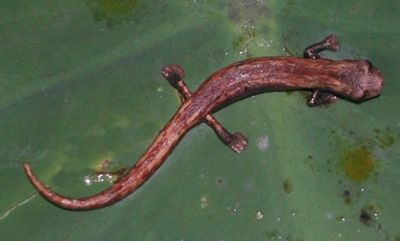Salamanders are evidence of older land connection between Central and South America
Published: 18 March 2013
The humble salamander may provide evidence to support a controversial claim that North and South America were joined together much early than previously thought.
The humble salamander may provide evidence to support a controversial claim that North and South America were joined together much early than previously thought.
The two continents are generally believed to have been joined together around three million years ago by the formation of a land bridge – what is now Panama – that sealed up the sea channel between them.
However, a new study of salamanders in South America by Dr Kathryn Elmer of the University of Glasgow, has found evidence that challenges these assumptions and supports a controversial claim by Smithsonian scientist Carlos Jaramillo that most of the Isthmus of Panama was formed around 23 million years ago[1].
 The fusion of both land masses led to a two-way migration of animals called the ‘Great American Biotic Interchange’, where animals that had previously evolved separately moved between the two continents, increasing the biodiversity in both regions.
The fusion of both land masses led to a two-way migration of animals called the ‘Great American Biotic Interchange’, where animals that had previously evolved separately moved between the two continents, increasing the biodiversity in both regions.
The relative dearth of species of salamander in South America – around 30 – compared to Central America, where there are more than 300 species, is usually attributed to the relatively short time the tiny amphibians have had to make their way south down the Isthmus of Panama – a thin strip of land only 30 miles wide at its narrowest point.
However, using DNA analysis, Dr Elmer found that salamanders in South America had much greater genetic divergence from their Central American cousins than should be expected if salamanders migrated across a three- million-year-old land bridge.
The evidence suggests salamanders colonised South America in the Early Miocene epoch, more than 20 million years ago, preceding the Great American Biotic Interchange by many millions of years.
 Dr Elmer said: “Unlike the mountains and forests of nearby Central America, the biodiversity of salamanders in the Andes and Amazon is quite low. Why are there so few species of salamanders in South America?
Dr Elmer said: “Unlike the mountains and forests of nearby Central America, the biodiversity of salamanders in the Andes and Amazon is quite low. Why are there so few species of salamanders in South America?
“When we began this study, all the literature said the Panama land bridge was three to four million years old. We struggled because our genetic data for salamanders were totally incompatible with the established geology.
“Then in 2011, studies from geologists started challenging the age of the Isthmus, saying it must be much older. This was welcome news to the salamander evolutionary biologists.”
Co-author David Wake, Professor of Integrative Biology and Curator of Herpetology at the University of California at Berkeley, said: “I started working on South American salamanders in 1960. In the early 1980s we obtained our first molecular data which showed that the South American group was quite differentiated and we went through some logical twists to explain this.
“For example, we suggested that perhaps the different lineages were of Central American origin, had differentiated there, and then migrated south, already having diverged. The one remote possibility was that the geologists were wrong and there had been land connections earlier than the 3.5 to 5 Ma normally given for completion of the Isthmian bridge.
“Salamanders are poor dispersers and they are unlikely to cross salt water gaps. Thus the new data, which show that even within what once was considered a single species, divergence is sufficiently great that there must have been an earlier land connection, is bringing home the near certainty of a land connection earlier, and of course this is what some controversial evidence from geologists such as Jaramillo is suggesting as well.
“In general, people working on amphibians and reptiles have been uncomfortable and dissatisfied with the 3.5-5 Ma date and the new much older dates are likely to meet with much approval.”
A second major finding from this research was the discovery of extensive cryptic species richness in South American salamanders, which suggests that until now their biodiversity in the upper Amazon has been substantially underestimated and there may be more species of salamander than believed.
Dr Elmer said: “When I was catching these salamanders in the jungle, I couldn't tell the difference between them just by looking at their colour and shape. But once we sequenced their DNA, we found that their genetic diversity is remarkably high – possibly higher than any group of salamanders that have been studied before.”
The researchers will now study the salamanders further and ascertain whether some of them should be classified as new species.
Other research on frogs and insects and trees has also found that the upper Amazon is home to many cryptic species. This is further evidence for the rich and largely uncatalogued biodiversity in this area, which is increasingly under threat from oil extraction and human expansion.
The research team, which includes Dr Elmer and researchers from Queen's University (Canada), University of Tulsa (USA) and University of California at Berkeley (USA), published their research in the open access journal BioMed Central Evolutionary Biology.
For more information contact Stuart Forsyth in the University of Glasgow Media Relations Office on 0141 330 4831 or email stuart.forsyth@glasgow.ac.uk
Notes to Editors
A research article describing this work, "Early Miocene origin and cryptic diversification in South American salamanders", by Kathryn R. Elmer, Ronald M. Bonett, David B. Wake, and Stephen C. Lougheed, is published in the open access journal BMC Evolutionary Biology.
(http://www.biomedcentral.com/1471-2148/13/59/)
First published: 18 March 2013
<< March

